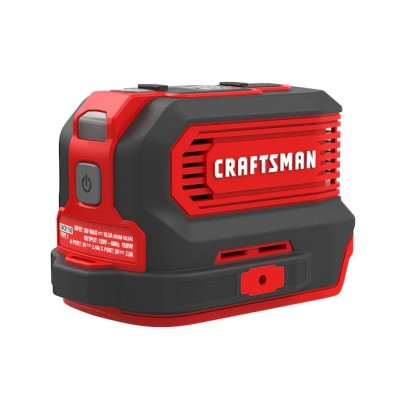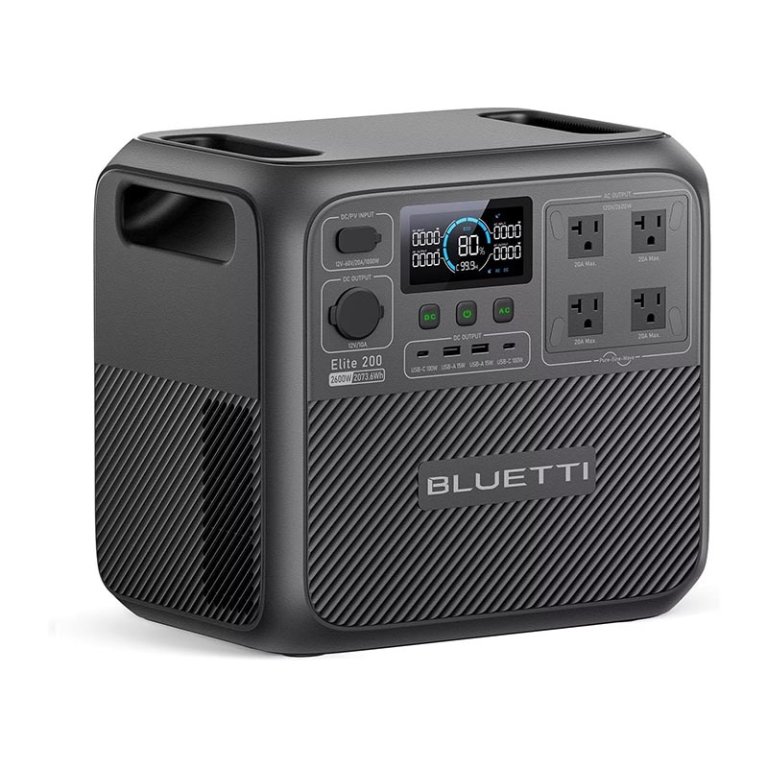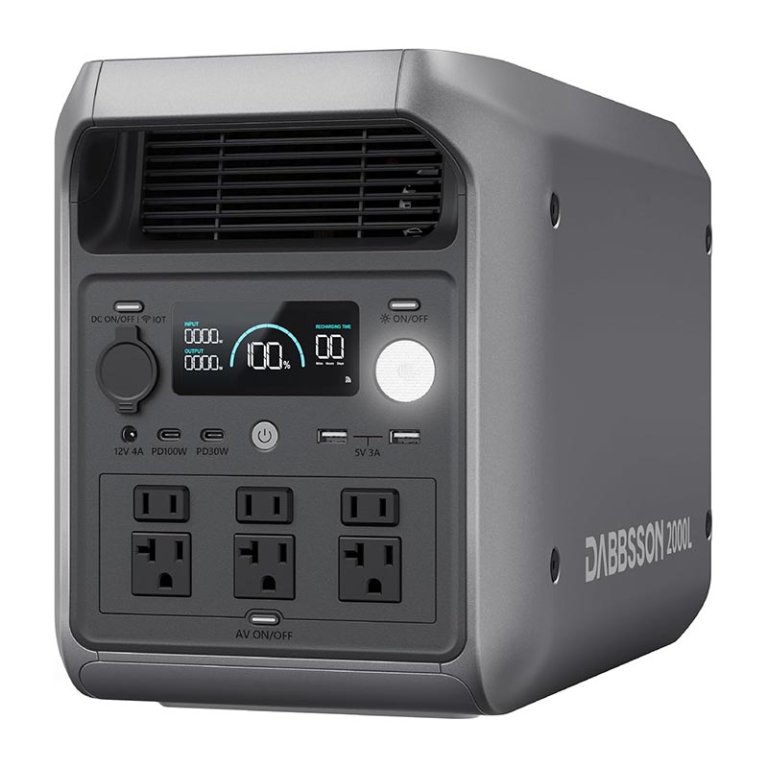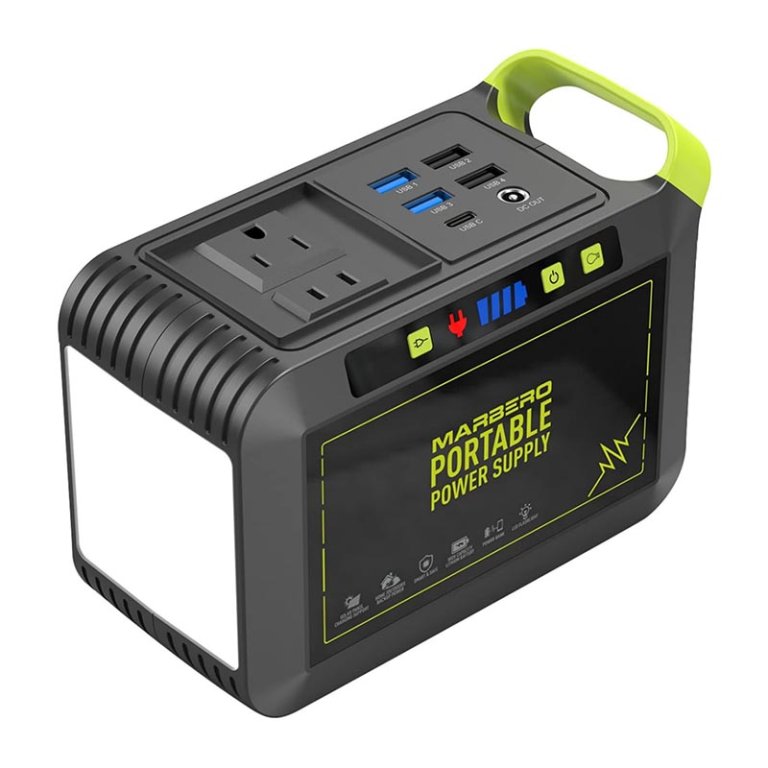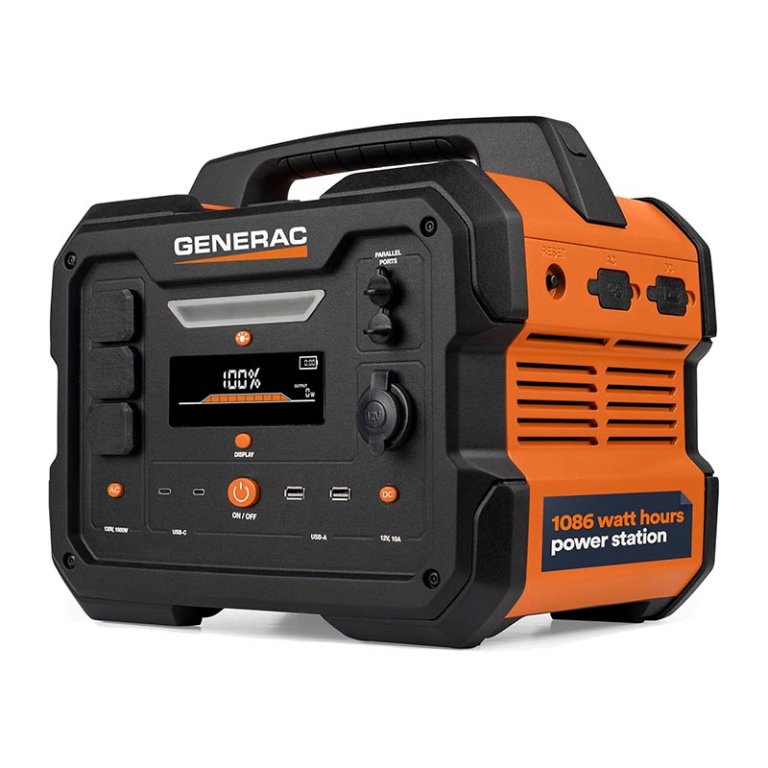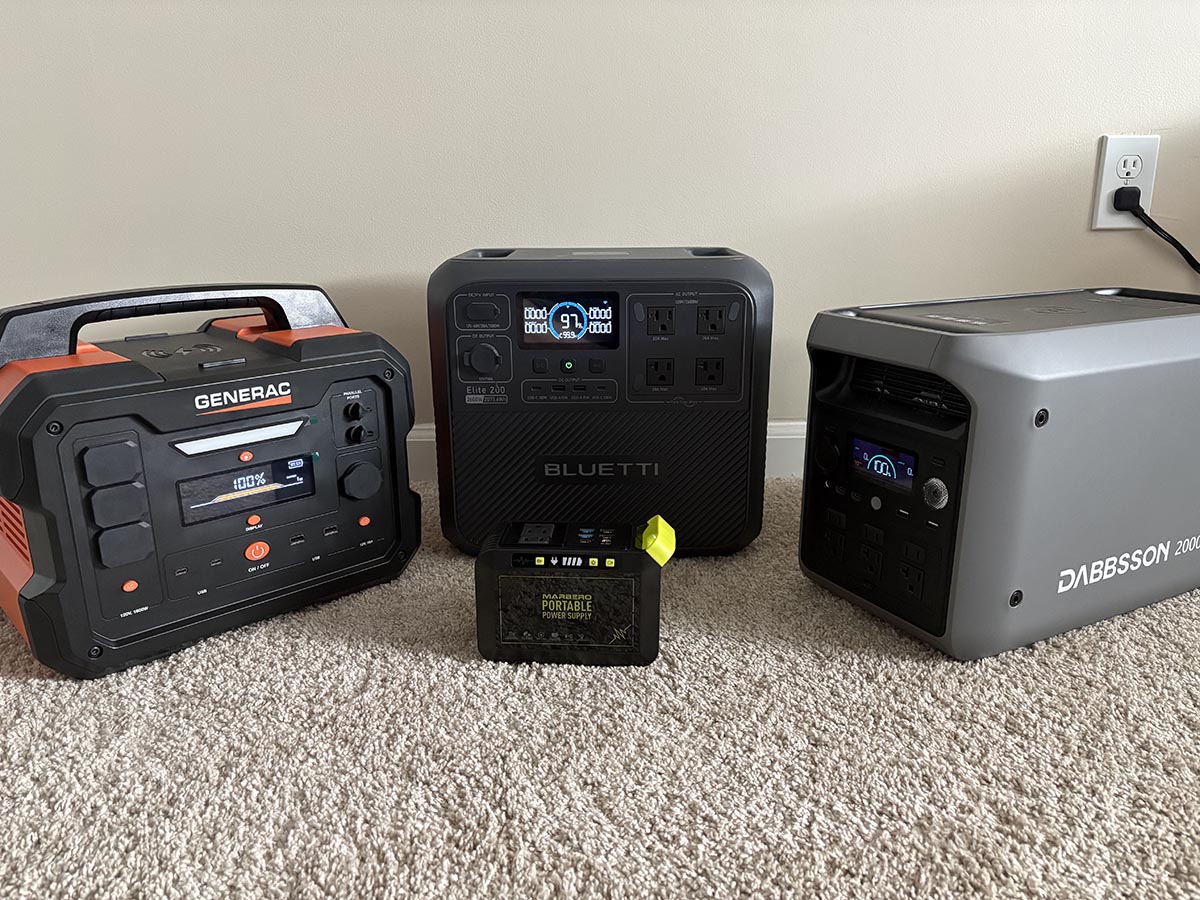
We may earn revenue from the products available on this page and participate in affiliate programs. Learn More ›
Portable power stations can deliver power when you need it most, whether during power outages or just for an off-grid adventure. These handy electricity suppliers vary in size, output, and energy source, not to mention durability. That’s why we’ve tested 22 models since 2022; some we’ve kept on this list, while others have been replaced by newer energy and power stations that we like even better. We spent hours testing some of the smaller models and days with some of the larger ones. We even took some on road trips to baseball tournaments and other events.
Our new top pick, the Bluetti Elite 200 V2, stood out for its exceptional battery capacity—among the highest of any model we tested that isn’t a whole-house unit—plus its rugged build quality and reliable output.
It’s not the only high-performing option, however. All of the following models make great picks for an emergency power station—in case the power goes out— or portable energy supply. Read our reviews on the top models below, along with important factors to consider before selecting the best portable power station for your needs.
- BEST OVERALL: Bluetti Elite 200 V2
↓ Jump to Review - BEST BANG FOR THE BUCK: Craftsman V20 150W Power Inverter
↓ Jump to Review - UPGRADE PICK: EcoFlow Delta 2 Max Portable Power Station
↓ Jump to Review - BEST FOR HOME BACKUP: Anker Solix F3800 Portable Power Station
↓ Jump to Review - BEST FOR ROAD TRIPS: Dabbsson 2000L Portable Power Station
↓ Jump to Review - BEST COMPACT: Marbero Portable Power Station
↓ Jump to Review - BEST WITH WIRELESS: Generac 1086Wh Portable Power Station
↓ Jump to Review

Portable Power Station Comparison
| Product | Power Output | Battery Capacity | Dimensions | Weight | Outlets/Ports |
| Bluetti Elite 200 V2 | 2,400 watts | 2,048 watt-hours | 14.4 inches long by 11 inches wide by 16.5 inches high | 62.4 pounds | 4 AC, 1 NEMA TT-30, 2 USB-A, 2 USB-C, 1 car port, 1 DC port |
| Craftsman V20 150W Power Inverter | 150 watts | Depends on the battery | 4.6 inches long by 3 inches wide by 3.2 inches high (tool only) | 0.7 pounds (tool only) | 1 AC, 1 USB-A, and 1 USB-C |
| EcoFlow Delta 2 Max Portable Power Station | 2,400 watts | 2,048 watt-hours | 12 inches long by 9.5 inches wide by 19.6 inches high | 50 pounds | 6 AC, 4 USB-A, 2 USB-C, 3 DC |
| Anker Solix F3800 Portable Power Station | 6,000 watts | 3,840 watt-hours | 15.6 inches long by 15.3 inches wide by 27.6 inches high | 132 pounds | 6 AC, 2 USB-A, 3 USB-C, 1 DC, 1 NEMA 14-50, 1 NEMA L14-30 |
| Dabbsson 2000L Portable Power Station | 2,200 watts | 2,048 watt-hours | 8.9 inches long by 18.3 inches wide by 11.2 inches high | 41 pounds | 6 AC, 2 USB-C, 2 USB-A, 1 car port, 1 DC5521 |
| Marbero Portable Power Station | 80 watts | 88 watt-hours | 6.5 inches long by 4.6 inches wide by 3 inches high | 2.3 pounds | 2 AC, 1 USB-C, 5.5 mm DC, 2 USB-A 5V, 2 USB-A QC |
| Generac 1086Wh Portable Power Station | 1,600 watts | 1,086 watt-hours | 14.1 inches long by 10.2 inches wide by 12 inches high | 29 pounds | 3 AC, 2 USB-A, 2 USB-C, 1 car port, wireless charger |
Our Top Picks
The following products rank among the best portable power stations in terms of quality, dependability, and price. Take a look and see some of the models we liked the most.
Best Overall
Photo: AmazonWhat We Like
- Massive capacity and high power output
- Fast solar and AC charging
- Excellent app integration and monitoring
- Premium build and design
What We Don’t Like
- Heavier than average
- High upfront cost
Product Specs
- Power output: 2,400 watts
- Battery capacity: 2,048 watt-hours
- Dimensions: 14.4 inches long by 11 inches wide by 16.5 inches high
- Weight: 62.4 pounds
- Outlets/ports: 4 AC, 1 NEMA TT-30, 2 USB-A, 2 USB-C, 1 car port, 1 DC port
Our Ratings: Portability 5/5; Performance 5/5; Value 5/5
The Bluetti Elite 200 V2 (also known as the AC200P V2) is the best portable power station we’ve tested to date. It’s a powerhouse that combines serious capacity with smart features and rock-solid reliability. We paired ours with Bluetti’s solar panels and were able to recharge it completely in a single sunny Florida day—getting roughly 5 percent per hour in full sun. The app integration makes it even better, showing real-time power flow, battery health, and device usage, so you can see exactly how efficiently it’s running. Between its four AC outlets, two USB-C ports, and multiple DC and car outputs, we could easily keep everything from phones and laptops to tools and appliances powered up at once.
In testing, it ran a full-size refrigerator for over 30 hours and powered a portable air conditioner for about 6 hours. That’s the kind of performance that puts it in a different league from typical “camping” power banks—it’s capable of running a household during an outage or acting as a reliable off-grid setup. The build quality feels premium, the interface is easy to navigate, and the LiFePO₄ battery chemistry ensures long-term durability.
The only real trade-off is its weight. At about 53 pounds, it’s technically portable but not something you’d want to haul far without help. Still, for home backup, van life, or RV use, it’s worth every ounce.
What our tester says: “Bluetti is definitely a rising star in the power world. You can’t ignore the premium feel of the products and the impressive performance.”—Paul Rankin, Product Reviews tester and writer
Read our full review: Bluetti Elite 200 V2
Get the Bluetti portable power station at Amazon, The Home Depot, Walmart, or Bluetti.
Best Bang For The Buck
Photo: Lowe’sWhat We Like
- Compact design fits in a toolbox
- Compatible with the lineup of 20-volt Craftsman batteries
- Versatile selection of outlets/ports
What We Don’t Like
- Storage depends on the battery it’s attached to
- Doesn’t come with a battery
Product Specs
- Power output: 150 watts
- Battery capacity: Depends on the battery
- Dimensions: 3.2 inches high by 3 inches wide by 4.6 inches deep (tool only)
- Weight: 0.7 pounds (tool only)
- Outlets/ports: 1 AC, 1 USB-A, and 1 USB-C
Our Ratings: Portability 5/5; Performance 4/5; Value 4/5
Craftsman blends affordability with portability and sprinkles a bit of capability on top with its 150-watt power inverter. This budget-minded model snaps onto any 20-volt battery from Craftsman, turning it into a small portable power station that you can take anywhere or store in a toolbox.
This power inverter features three ports: a USB-A, a USB-C, and a standard AC outlet. It also has a built-in work light to illuminate work or a path back to the truck. Runtime will be determined by the size of the battery it’s on, but with a 150-watt output, it can handle lamps, cell phones, and other devices.
In our opinion, this affordable little inverter is ideal for the jobsite. It can quickly turn any 20-volt Craftsman battery into a power station, allowing folks to charge their phones, power drop lights, or even charge a laptop when there isn’t a battery source nearby. Is it full of possibilities? Not quite, as it’s limited to the battery it’s attached to, but we think anyone with Craftsman batteries ought to consider adding it to their toolbox for its convenience and affordability.
Get the Craftsman portable power station at Amazon, Lowe’s, Ace Hardware, or Walmart.
Upgrade Pick
Photo: AmazonWhat We Like
- Can keep a full-size fridge running for 14 hours
- Has a long-lasting lithium-iron phosphate (LFP) battery
- Enough ports to power 15 devices at once
What We Don’t Like
- No 30-amp outlet to run an RV
- The heaviest model we tested
Product Specs
- Power output: 2,400 watts
- Battery capacity: 2,048 watt-hours
- Dimensions: 12 inches long by 9.5 inches wide by 19.6 inches high
- Weight: 50 pounds
- Outlets/ports: 6 AC, 4 USB-A, 2 USB-C, 3 DC
Our Ratings: Portability 3/5; Performance 5/5; Value 4.5/5
During testing, we were impressed with the performance and huge array of output options on the EcoFlow Delta 2 Max. With a total of 15 outlets/ports and 2,400 running watts of power, we found it to be the most rugged and versatile option in our lineup. While some power stations on our list are better for shorter and less demanding circumstances, this beast from EcoFlow can power a full-size refrigerator for up to 14 hours.
This EcoFlow power station uses an LFP (or LiFePO4) battery, which has nearly twice the expected lifespan of traditional lithium-ion batteries. It charges via wall outlet, 12-volt car outlet, or solar panels. Its large display is easy to read and clearly displays output and expected runtime based on current usage. Though we think this unit provides an excellent value, it is the heaviest power station we tested. It also doesn’t have a 30-amp outlet to power an RV. (If that’s something you’re after, check out our Jackery solar generator review.)
The Delta 2 Max has one of the highest price tags in our lineup, but if you’re looking for convenience and reliable backup power, it’s worth the money. For even more power and versatility, you can add one or two extra Delta Max smart batteries at 2,016 kilowatt hours each, for a maximum total storage capacity of 6,080 kilowatt hours.
Read our full review: EcoFlow Delta 2 Max Portable Power Station
Get the EcoFlow Delta 2 Max portable power station at Amazon, Lowe’s, The Home Depot, or EcoFlow.
Best For Home Backup
Photo: AmazonWhat We Like
- Supplies up to 9,000 surge watts
- Capable of powering the whole house or RV
- 4 locking casters for easy transport
- Expandable storage capacity up to 26,880 watt-hours
- Fully charges in about 2 hours
What We Don’t Like
- Bulky and heavy, limited portability
- May not handle HVAC surge watts
Product Specs
- Power output: 6,000 watts
- Battery capacity: 3,840 watt-hours
- Dimensions: 15.6 inches long by 15.3 inches wide by 27.6 inches high
- Weight: 132 pounds
- Outlets/ports: 6 AC, 2 USB-A, 3 USB-C, 1 DC, 1 NEMA 14-50, 1 NEMA L14-30
Our Ratings: Portability 3/5; Performance 4.5/5; Value 5/5
Whole-home backup power is an area where portable power stations have lagged, but the Anker Solix F3800 bridges the gap. This powerful and portable unit boasts a whopping 6,000 running watts; 9,000 surge watts; and 3,840 watt-hours in its base configuration, with options for expandability up to 26,880 watt-hours. That’s enough to keep the refrigerator, deep freezer, and key household outlets operational through an extended power outage.
The F3800 is unique, not only in size of its battery reserves but also in that it is equipped with a 120/240-volt NEMA 14-50 outlet that can be directly connected to an electrical subpanel. It also features a NEMA L14-30 outlet that can directly power an RV for a weekend getaway. Make no mistake: This amount of battery storage is larger and heavier than the other models we tested, but an extendable handle, two 4-inch rollers, and two 2-inch locking casters make it easier to transport. Plugged into a wall outlet, the unit fully recharged from 15 percent in less than 2.5 hours.
Our limited test showcased the remarkable ability of the base setup, but it barely scratched the surface of what an expanded Anker Solix system could accomplish. As with some other portable power stations, two F3800s can be paired to deliver 12,000 watts of power. Adding up to 6 expansion batteries per power station boosts storage capacity to as much as 53,800 kilowatt-hour (kWh) in a dual F3800 system. Each power station is capable of accepting up to 2,400 input watts from solar panels to recharge and further extend runtime.
What our tester says: “The F3800 powered a window air conditioner, a full-size refrigerator, a microwave, three table lamps, a Wi-Fi router, and a television during my testing. When the refrigerator or air conditioner entered the active cooling cycle, the surge did not affect the other devices.”—Tom Scalisi, Product Reviews tester and writer
Get the Anker portable power station at Amazon, Lowe’s, The Home Depot, Tractor Supply Co., or Anker.
Best for Road Trips
Photo: AmazonWhat We Like
- Lightweight design for its power class
- Fast 90-minute wall charging
- Impressive solar charging performance
- Built-in motion-sensing headlight
What We Don’t Like
- Limited app connectivity or smart controls
- May not handle HVAC surge watts
Product Specs
- Power output: 2,200 watts
- Battery capacity: 2,048 watt-hours
- Dimensions: 8.9 inches long by 18.3 inches wide by 11.2 inches high
- Weight: 41 pounds
- Outlets/ports: 6 AC, 2 USB-C, 2 USB-A, 1 car port, 1 DC5521
Our Ratings: Portability 5/5; Performance 5/5; Value 4.5/5
The Dabbsson 2000L Portable Power Station is a surprisingly compact powerhouse that’s perfect for road trips, camping, or emergency backup at home. Weighing just 41 pounds, it’s one of the lightest 2 kWh units we’ve tested, yet it still delivered enough juice to run a full-size refrigerator and freezer for a full 24 hours during testing in Florida. That combination of high output and portability makes it a great fit for travelers and RV users who want serious power without the bulk. It also recharges impressively fast—going from empty to full in just over 90 minutes when plugged into a standard wall outlet.
The thoughtful extras set it apart from many competitors. A built-in headlight with motion detection adds real convenience when camping or navigating in the dark, and the app-free simplicity makes it easy to use right out of the box. We also tested it with third-party solar panels and saw strong performance, gaining about 15 percent per hour under full sun. That kind of solar efficiency adds serious flexibility when you’re off the grid for extended stretches.
While it’s not featherlight, the dual-handle design makes carrying manageable, and its sleek profile stores neatly in a car or RV compartment. For travelers and adventurers who want reliable power on the go, the Dabbsson 2000L nails the balance between performance, portability, and practicality.
Get the Dabbsson portable power station at Amazon or Dabbsson.
Best Compact
Photo: AmazonWhat We Like
- Fits in one hand
- Extremely lightweight and portable
- Multiple ports and charging options
- SOS and multi-mode flashlight
What We Don’t Like
- Limited power output (80 watts max)
- Slower charging for larger devices
Product Specs
- Power output: 80 watts
- Battery capacity: 88 watt-hours
- Dimensions: 6.5 inches long by 4.6 inches wide by 3 inches high
- Weight: 2.3 pounds
- Outlets/ports: 2 AC, 1 USB-C, 5.5 mm DC, 2 USB-A 5V, 2 USB-A QC
Our Ratings: Portability 5/5; Performance 3.8/5; Value 4/5
The Marbero Portable Power Station earns a spot in our lineup thanks to its ultra-lightweight, handheld design and surprising versatility for such a small unit. Weighing just 2.3 pounds, it’s small enough to toss in a backpack or glove compartment, making it perfect for camping, road trips, or emergency use at home. Despite its tiny size, the portable small power station offers an 88.8-watt-hour capacity and enough output to power or charge most small electronics—smartphones, tablets, cameras, or even a laptop under 80 watts. During testing, it fully charged an iPad Pro in about 5 hours, and the built-in LED light ran for more than 13 hours on a single charge.
What makes the Marbero stand out is how thoughtfully it’s designed for mobility and safety. There’s a sturdy handle for clipping to a bag, multiple output options including USB-A, USB-C, and AC ports, and built-in protections against overvoltage, overheating, and short circuits. It can recharge via a wall outlet or solar panel, giving it solid flexibility for travel or off-grid use. And that SOS light mode? It’s a small but smart feature that could genuinely come in handy during an outage or roadside emergency.
This isn’t a unit for running appliances or high-wattage gear (it even comes with a warning message not to try to plug in high-wattage items), but for small-device charging on the go, it’s an ideal pick. Few power stations pack this much function into such a portable package.
Get the Marbero portable power station at Amazon or Marbero.
Best with Wireless
Photo: AmazonWhat We Like
- Fast wall charging (0 to 80 percent in 2 hours)
- Wireless phone charging pad
- Large, easy-to-read color display
- Built-in MPPT solar controller
What We Don’t Like
- Louder than average while charging
- Plastic buttons feel less premium
Product Specs
- Power output: 1,600 watts
- Battery capacity: 88 1,086 watt-hours-hours
- Dimensions: 14.1 inches long by 10.2 inches wide by 12 inches high
- Weight: 29 pounds
- Outlets/ports: 3 AC, 2 USB-A, 2 USB-C, 1 car port, wireless charger
Our Ratings: Portability 4.5/5; Performance 4/5; Value 4/5
The Generac GB1000 Portable Power Station brings the brand’s trusted generator expertise into a compact, gas-free format ideal for camping, tailgating, or home backup. With a 1,086Wh capacity, it can power small appliances, tools, and electronics with clean, quiet energy—no fumes or fuel required. In testing, it performed well across the board, offering multiple charging options (AC, DC, USB-A, USB-C, and a 15-watt wireless charging pad) and an impressively fast recharge time of about two hours from a wall outlet. The built-in MPPT controller also supports direct solar charging without extra accessories (just note that solar panels are sold separately), making it a convenient off-grid solution.
While not the most refined model we tested, the GB1000 stands out for practicality. The wireless charging pad on top makes it easy to keep a phone powered while freeing up other ports, and the large color display is excellent for checking battery levels and remaining runtime at a glance. We also appreciated the small rear storage pouch for cables—a thoughtful touch for road trips and campsite setups. At 43 pounds, it’s not light, but the ergonomic handle makes it easier to move between car, campsite, and home.
The biggest downside is that it’s louder than most other power stations while charging, with a noticeable hum from its fans. Still, once it’s topped off, it runs quietly and delivers reliable performance from a trusted name in power equipment.
Get the Generac portable power station at Amazon, The Home Depot, Ace Hardware, or Walmart.
Jump to Our Top Picks
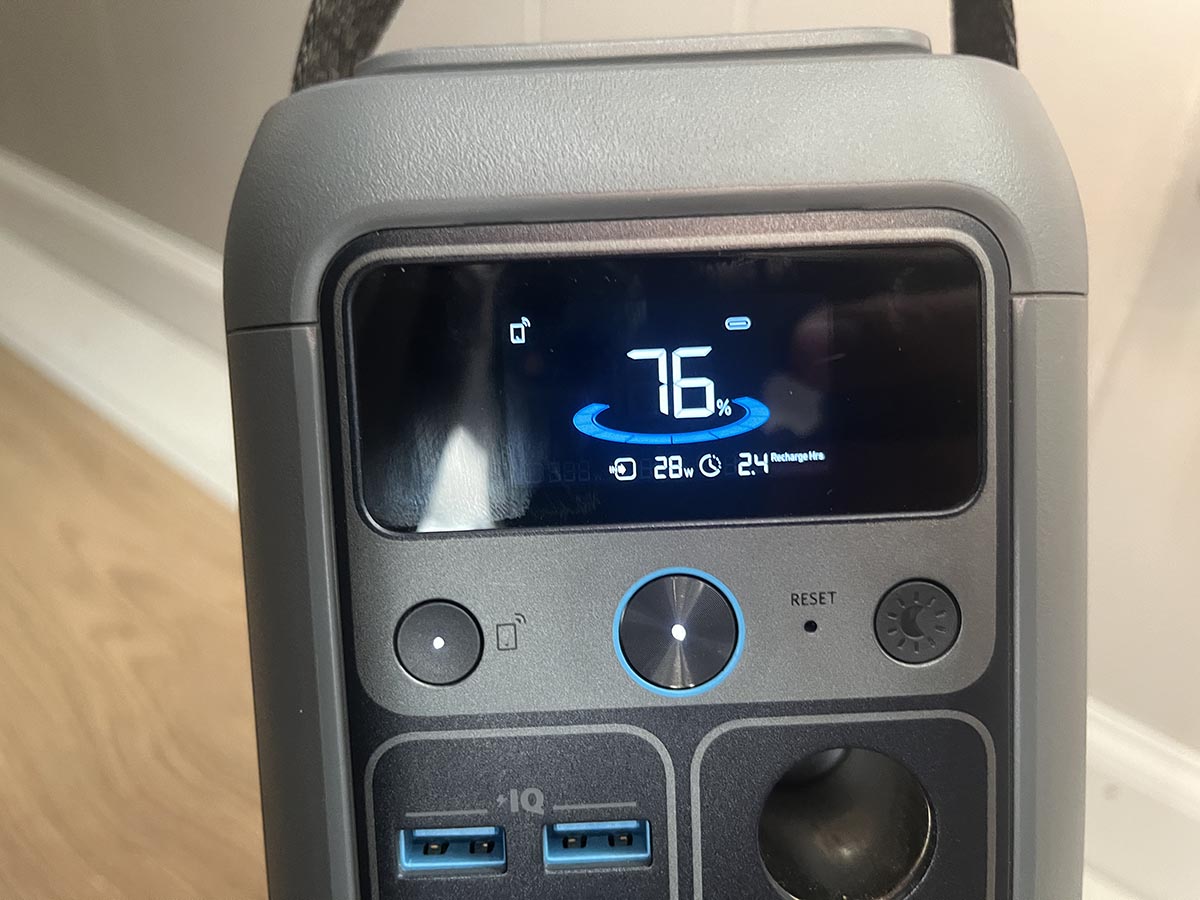
How We Tested the Best Portable Power Stations
| Testing Stats | |
| Products tested | 22 |
| Time spent testing | Over 1 year |
| Tests performed | 6 |
| Price range | $49 to $1,900 |
To determine the best portable power stations, we put 22 models through a series of structured tests designed to measure performance, portability, and real-world usability. Each unit was evaluated for charging speed, output efficiency, and overall design, with every model subjected to the same testing criteria.
For smaller power stations, we tested performance by charging everyday electronics—phones, tablets, and laptops—while tracking charge and discharge rates. We also ran small devices like desk fans and lamps to see how long each unit could sustain light-to-moderate power draw. Portability was a key factor, so we weighed and measured each unit, noting how compact and travel-friendly they were.
Larger power stations faced more rigorous testing. We used them as emergency backups during power outages to keep refrigerators, routers, TVs, and lights running, then pushed them further by connecting high-demand appliances like air conditioners and space heaters. These stress tests revealed how efficiently each model handled surge loads and sustained heavy use.
From this extensive testing, we selected our final seven award winners—each chosen for excelling in a specific area such as capacity, portability, or value. While several previously tested models like the DJI Power 1000, Vtoman FlashSpeed 1000, and EcoFlow River 2 Pro performed impressively and remain excellent choices, they were ultimately edged out by newer or higher-performing units in our latest round of testing.

What to Consider When Choosing a Portable Power Station
Keep these important factors and product features in mind when shopping for the best portable power station to keep devices charged or run appliances when the power goes out (or when you’re off-grid). Note that while power stations and generators are different types of power sources, the terms are often used interchangeably. See the FAQ below for key differences.
Types of Portable Power Stations
The top portable power stations, also often called portable power generators, fall into two broad categories based on the method they use to collect and store energy: electric and solar. Many times, solar portable power stations are also rechargeable via AC power, serving as a rechargeable generator of sorts.
Electric
Electric power stations, also known as portable electric generators, operate like a large battery. Simply plug the electric power station into a wall outlet and it charges quickly. Some power stations may also charge in a car power outlet, provided they have the correct adapter, but this takes longer than it does in a standard outlet.
These models work best for indoor purposes and devices with low power requirements, such as cell phones or flashlights. Some products pair with a compatible solar panel to charge using the sun, making them a home solar generator of sorts.
Solar
If camping is the primary intended use for a portable power station, then look for a portable solar power generator that can charge during the day in the sun. Come nighttime, the portable solar station should be ready to provide hours of power.
In the past, solar power stations only could charge using sunlight, which greatly limited their reliability. However, manufacturers have begun combining solar and electric portable power stations to give users the option to charge using a traditional electric outlet; a vehicle power outlet; or detachable, portable solar panels. Steadily, this hybrid idea has become one of the best outdoor power station designs. It combines all the advantages of solar energy and the convenience of electrical outlets. Today, very few power stations offer only solar or only electric power.
Power Output
Power output of a portable power supply station refers to the maximum amount of energy the station delivers to the attached devices.
Power output ratings are available in terms of wattage. How many watts a device will deliver explains how much power it can produce. The more watts a device can produce, the larger the electrical component it can run. For instance, a 100-watt power supply can power two 50-watt bulbs. However, it can’t run an air conditioner, which requires around 450 watts to run its compressor.
Power capacity is a different story, and it’s measured in milliamp-hours or watt-hours. Both terms explain how long the power station can power a device of a specific size. A portable power source with a 2,000-milliamp-hour battery can charge or power a device that draws 200 millilamp-hours for 10 hours. A station with 1,000 watt-hours can power a 1-watt device for 1,000 hours, or a 400-watt device for 2.5 hours. Generally speaking, smaller power supplies use milliamp-hours, while the most powerful portable power station supply units use watt-hours.
Weight
Electric and solar-powered generator units are generally smaller and lighter than gas-powered generators, which makes them the ideal power station for camping and road trips. Folks looking for the best portable power supply will want to look for a manageable size and weight as well as features that facilitate transport, such as wheels and a carrying handle.
Noise
Consider how much noise a power station will make. Setting one up inside a home or workshop means close quarters, and loud models may require hearing protection. A portable power station for camping should also be quiet, or else it may disturb the neighbors.
Typically, electric and solar power stations make for the quietest generators available. These products don’t make much noise at all because they only transfer stored energy. They hum no louder than a mini fridge. (For those who may require more electricity than a power station can supply, but still need a quieter source of power, inverter generators are a good option.)
Safety Features
Anyone operating a device that uses electricity will want to be aware of the potential risks, such as overheating. Look for portable power stations that have built-in safety features like an automatic shutdown function, overload protection, and an internal high/low-temperature gauge.
- An automatic shutdown function helps prevent premature degradation of the power station by turning the device off before it overheats or protecting the battery from discharging too deeply.
- Overload protection disengages the portable power station from the input current if it detects that the current is exceeding a safe charge capacity.
- An internal high/low-temperature gauge measures the temperature of the battery and stops all input and output functions if the battery temperature falls outside of a safe range, as determined by the manufacturer.
Durability
Whether using a portable power station at home, camping, or on the jobsite as a power tool recharging station, it’s vital to invest in a product that will withstand any method of transportation and any possible impact damage that could occur. If you’re using the power station within the home or workshop exclusively as a backup power device, then a lightweight product may be fine.
If you’re using a portable battery power station for camping, consider products that offer water and ultraviolet resistance. On a jobsite, look for a heavy-duty product that won’t break down if a wrench or hammer falls on top of it.
Battery and Charging Method
Portable power stations typically come equipped with lithium-ion batteries that hold a significant amount of stored electrical energy. Most power stations plug directly into a standard electrical outlet, but many models don’t require access to a wall outlet.
Some portable power stations charge in cars with the proper adapter—a great method for camping and road trips. With the right conditions, solar charging works well. These models need a compatible solar panel, the appropriate weather for efficient solar charging, and a suitable place to leave the portable power station where it will absorb solar energy. Power stations with multiple charging methods make an excellent resource for long camping trips because they help to ensure power in almost any situation.
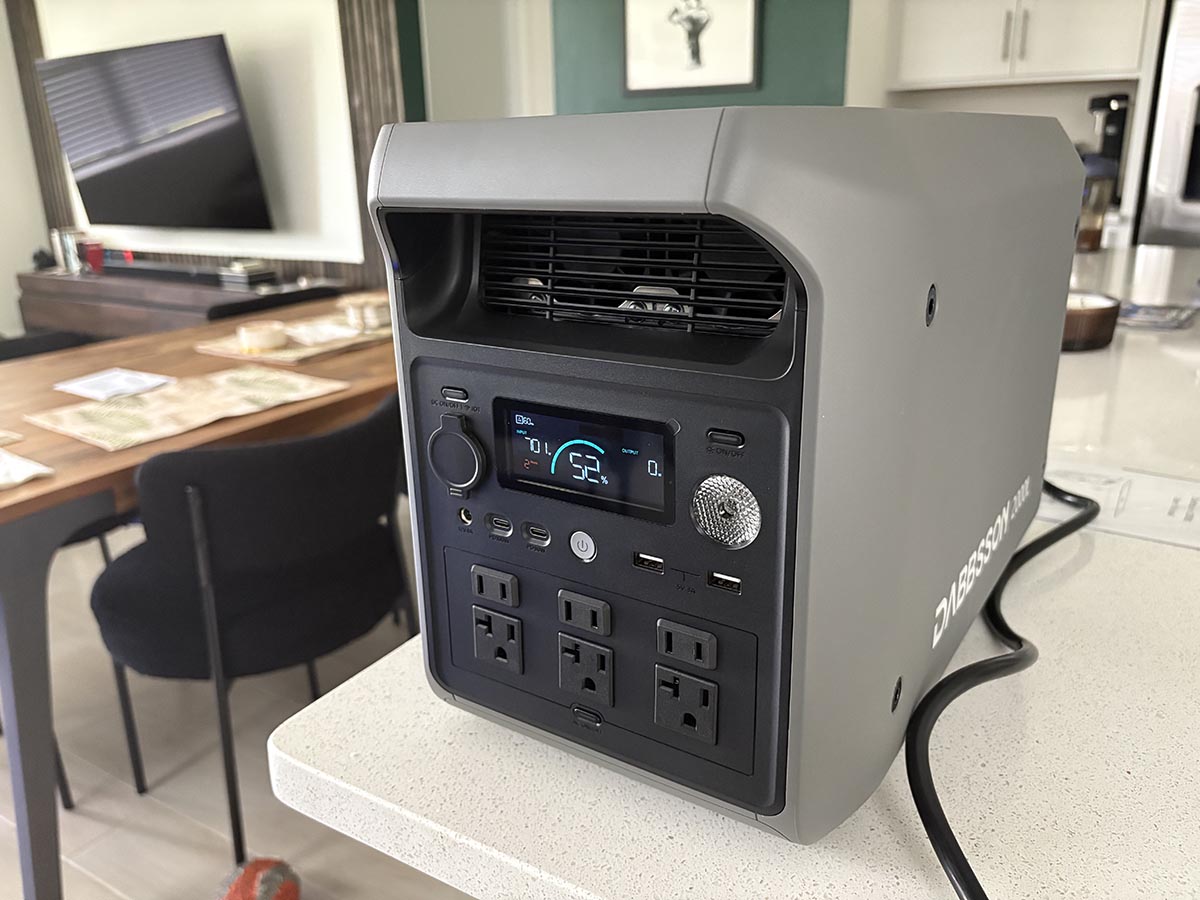
FAQs
The number of devices you can charge simultaneously depends on the type of devices being charged, the power output of the battery, and the number of outlets available on the portable charging station. Average portable power stations typically charge two to three devices at one time. However, if the plugged-in devices draw more power than the rechargeable power station puts out, then the power station won’t power all of the devices simultaneously.
A generator uses gasoline or another fuel to create electrical energy instead of simply storing electrical energy. Home generators in particular are much larger tools that are designed for supporting a significantly higher number of electronics. Many generators supply power for an entire home, while lightweight portable power stations work best with small appliances and electronic devices, almost like they’re cheap home generators.
You can use an online wattage calculator to determine the electrical load of the appliances in your home. As long as the wattage of the appliances you’d like to power does not exceed the running wattage of the portable power station, then the power station can run your appliances.
It’s best to leave a portable power station inside, or at least under some cover, as these units are not typically waterproof. However, as long as you protect the portable power station from water, you can leave it outside. In fact, it must stay outside to charge on a solar panel, preferably in a sunny location.
Some key safety tips about portable power stations include:
Use the correct cables with the correct outlets.
Place cables off the ground to avoid a tripping hazard.
Do not use devices that exceed the running wattage of the power station.
Avoid exposing portable power stations to water.
Charge time depends on the individual product and the charging method. For instance, a portable power station may be able to charge fully in just 2 hours when it’s plugged into a power outlet, but it may take over 8 hours to charge a portable power station fully with a solar panel.
Don’t add to growing e-waste problems by throwing an old battery-powered generator in the trash. Instead, take it to a local electronics recycling location. Usually a municipality or town will have a program for recycling electronics, and some retailers, such as Best Buy, also offer e-waste recycling programs.
Meet the Testers
Paul Rankin is a product tester and writer specializing in hands-on reviews of home, outdoor, and tech gear. He’s tested everything from portable power stations and grills to smart home devices and tools, with a focus on real-world performance and design.
Tom Scalisi is a full-time DIY and construction writer for many of the largest websites in the industry, including BobVila.com, This Old House, Family Handyman, and Forbes.
Mark Wolfe is a DIY writer and product tester with a curiosity about emerging battery technology. He enjoys pushing cordless shop tools and outdoor power equipment to their limit, and finding the best new ways to keep his equipment up and running on the go.
Additional research provided by Timothy Dale.

